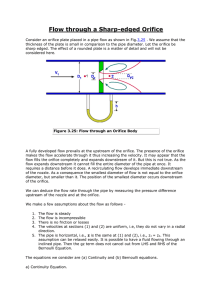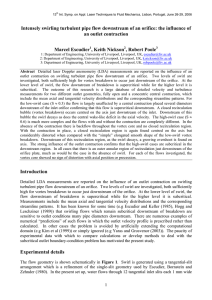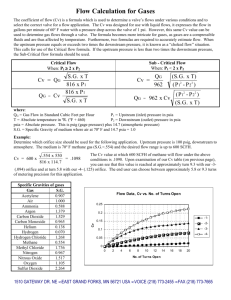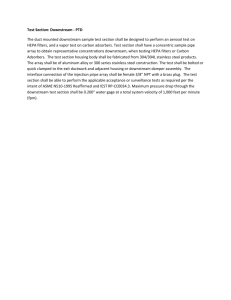Intensely swirling turbulent pipe flow downstream of an orifice: the... contraction
advertisement
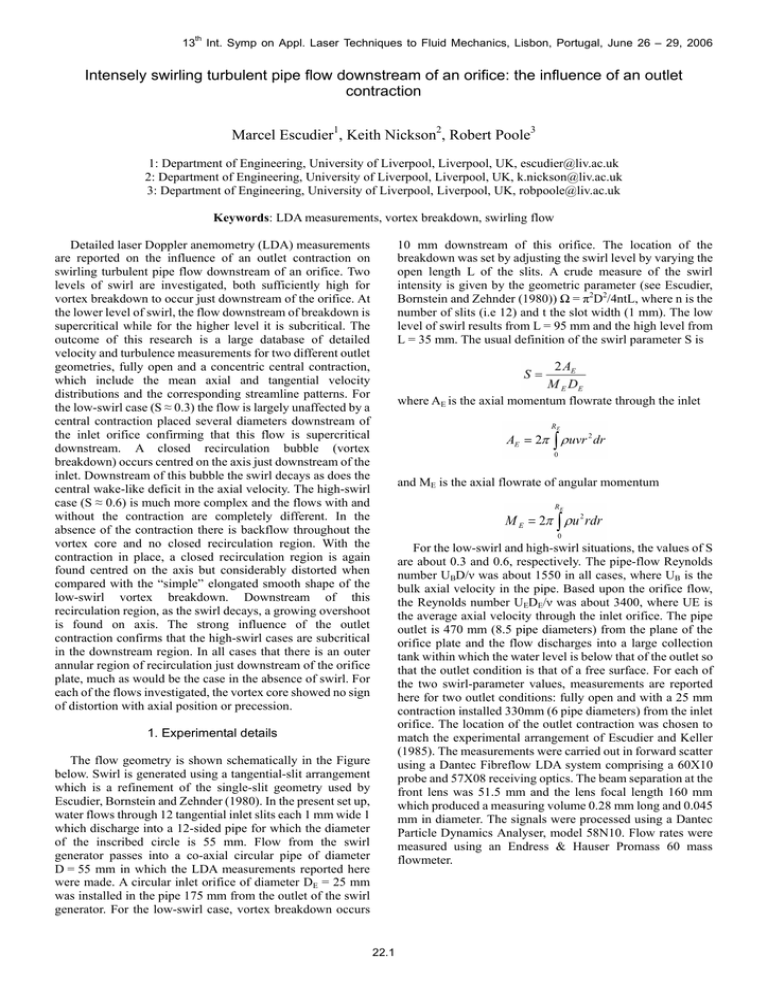
13th Int. Symp on Appl. Laser Techniques to Fluid Mechanics, Lisbon, Portugal, June 26 – 29, 2006 Intensely swirling turbulent pipe flow downstream of an orifice: the influence of an outlet contraction Marcel Escudier1, Keith Nickson2, Robert Poole3 1: Department of Engineering, University of Liverpool, Liverpool, UK, escudier@liv.ac.uk 2: Department of Engineering, University of Liverpool, Liverpool, UK, k.nickson@liv.ac.uk 3: Department of Engineering, University of Liverpool, Liverpool, UK, robpoole@liv.ac.uk Keywords: LDA measurements, vortex breakdown, swirling flow Detailed laser Doppler anemometry (LDA) measurements are reported on the influence of an outlet contraction on swirling turbulent pipe flow downstream of an orifice. Two levels of swirl are investigated, both sufficiently high for vortex breakdown to occur just downstream of the orifice. At the lower level of swirl, the flow downstream of breakdown is supercritical while for the higher level it is subcritical. The outcome of this research is a large database of detailed velocity and turbulence measurements for two different outlet geometries, fully open and a concentric central contraction, which include the mean axial and tangential velocity distributions and the corresponding streamline patterns. For the low-swirl case (S ≈ 0.3) the flow is largely unaffected by a central contraction placed several diameters downstream of the inlet orifice confirming that this flow is supercritical downstream. A closed recirculation bubble (vortex breakdown) occurs centred on the axis just downstream of the inlet. Downstream of this bubble the swirl decays as does the central wake-like deficit in the axial velocity. The high-swirl case (S ≈ 0.6) is much more complex and the flows with and without the contraction are completely different. In the absence of the contraction there is backflow throughout the vortex core and no closed recirculation region. With the contraction in place, a closed recirculation region is again found centred on the axis but considerably distorted when compared with the “simple” elongated smooth shape of the low-swirl vortex breakdown. Downstream of this recirculation region, as the swirl decays, a growing overshoot is found on axis. The strong influence of the outlet contraction confirms that the high-swirl cases are subcritical in the downstream region. In all cases that there is an outer annular region of recirculation just downstream of the orifice plate, much as would be the case in the absence of swirl. For each of the flows investigated, the vortex core showed no sign of distortion with axial position or precession. 10 mm downstream of this orifice. The location of the breakdown was set by adjusting the swirl level by varying the open length L of the slits. A crude measure of the swirl intensity is given by the geometric parameter (see Escudier, Bornstein and Zehnder (1980)) Ω = π2D2/4ntL, where n is the number of slits (i.e 12) and t the slot width (1 mm). The low level of swirl results from L = 95 mm and the high level from L = 35 mm. The usual definition of the swirl parameter S is where AE is the axial momentum flowrate through the inlet and ME is the axial flowrate of angular momentum For the low-swirl and high-swirl situations, the values of S are about 0.3 and 0.6, respectively. The pipe-flow Reynolds number UBD/ν was about 1550 in all cases, where UB is the bulk axial velocity in the pipe. Based upon the orifice flow, the Reynolds number UEDE/ν was about 3400, where UE is the average axial velocity through the inlet orifice. The pipe outlet is 470 mm (8.5 pipe diameters) from the plane of the orifice plate and the flow discharges into a large collection tank within which the water level is below that of the outlet so that the outlet condition is that of a free surface. For each of the two swirl-parameter values, measurements are reported here for two outlet conditions: fully open and with a 25 mm contraction installed 330mm (6 pipe diameters) from the inlet orifice. The location of the outlet contraction was chosen to match the experimental arrangement of Escudier and Keller (1985). The measurements were carried out in forward scatter using a Dantec Fibreflow LDA system comprising a 60X10 probe and 57X08 receiving optics. The beam separation at the front lens was 51.5 mm and the lens focal length 160 mm which produced a measuring volume 0.28 mm long and 0.045 mm in diameter. The signals were processed using a Dantec Particle Dynamics Analyser, model 58N10. Flow rates were measured using an Endress & Hauser Promass 60 mass flowmeter. 1. Experimental details The flow geometry is shown schematically in the Figure below. Swirl is generated using a tangential-slit arrangement which is a refinement of the single-slit geometry used by Escudier, Bornstein and Zehnder (1980). In the present set up, water flows through 12 tangential inlet slits each 1 mm wide 1 which discharge into a 12-sided pipe for which the diameter of the inscribed circle is 55 mm. Flow from the swirl generator passes into a co-axial circular pipe of diameter D = 55 mm in which the LDA measurements reported here were made. A circular inlet orifice of diameter DE = 25 mm was installed in the pipe 175 mm from the outlet of the swirl generator. For the low-swirl case, vortex breakdown occurs 22.1

